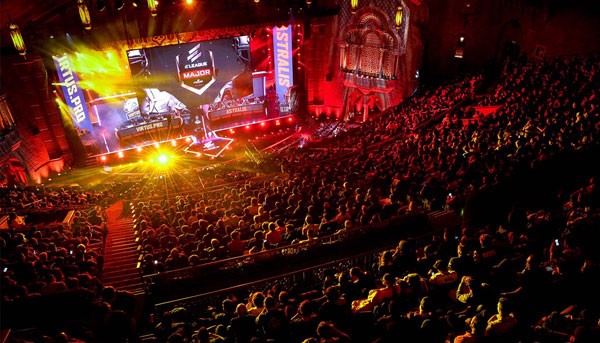High-performance computer hardware maker, HyperX, has sponsored eSports for over a decade. It is a major sponsor at ESL and MLG tournaments, and it didn’t hesitate to become one when ELeague started last year. The company provides high-end headsets for ELeague players who compete on both online streaming and televised broadcasts while highlighting top-performing players in a special spot called the “X Factor.” Additionally, it engages the eSports community with content such as the “HyperX BootCamp,” which adds a fun spin to eSports training with some off-the-wall activities.
Late last month, ELeague hosted its first CS:GO Major tournament from the historic Fox Theatre in Atlanta, Georgia. The sold out Major Grand Final (which aired on TBS) became the first event in the history of Twitch to surpass one million concurrent viewers. The success shows how eSports viewership remains primarily on digital, even though considerable progress is being made with popularizing it on television.
HyperX’s director of corporate marketing, Daniel Kelley, spoke with [a]listdaily about working with ELeague and the company’s long history with the eSports scene.

What drew HyperX to become an ELeague sponsor?
HyperX has been a major sponsor of ESL, MLG and other tried-and-true eSports tracks. So, when ELeague approached us and we saw that Turner was behind it—I’m a big fan of the broadcasts that Turner puts on with TNT and TBS—and we really liked what Turner was trying to do. [They were looking to] capture the excitement of eSports and developing a high production league and taking that leap of putting it on broadcast TV, but not losing the fact that online streaming and the accessibility of eSports is important to its biggest fan base. They made sure that all of the online consumption via Twitch was there, but they thought they could get some crossover to a broader audience with the cable TV show.
Also, we knew that they would be coming at it with a long-term investment and a high production value. A lot of what we try to do as a brand was to not only keep our commitment to a hardcore PC gaming audience, but branch out to wider gamers in general. It all sort of aligned, and from there, we got into the typical negotiations and everything else. Fast forward a year, and I’d say what they pulled off with the ELeague CS:GO Major having over a million Twitch viewers watch is pretty impressive. We’re very happy with the partnership and we look forward to it being a long-lasting one.
Is there a difference between approaching the ELeague sponsorship compared to the ESL when considering the television viewing audience?
I’d say it’s still pretty straightforward with the online broadcasts and the in-stream branding and placements. We approach it knowing that most of eSports content is going to be consumed online and digitally, so we wanted that to be our number one priority for branding and product messaging. But we did factor television into our negotiations and our approach. We had a lot of spots that ran on TBS each season, which gave us a nice widening of our brand awareness to casual fans. It was a slightly different approach, but I’d say the core method of leveraging these sponsorships was very similar to what we do with ESL and others.
How was HyperX integrated into ELeague?
We have our logo branding on the overlay of the online stream. We also worked with ELeague on the “X Factor” highlights during matches, which highlights a particular player and their performance during a game or match. It’s an ongoing HyperX-focused callout of someone who is doing well. There was also some in-stadium branding, and we were able to set up shop at the Majors, where people could come to our booth and try on our headsets. That’s all in addition to the 30-second spots that we worked with Turner on and the ELeague sponsorship.
How did the “HyperX BootCamp” promotion come together?
That was a very exciting time here and was a crazy week, for sure—having both Na’Vi and SK Gaming here. We did all kinds of fun activities in addition to having them play the games that they know so well and the fans crave. That actually came very collaboratively through a proactive approach on the teams’ side, and we embraced it and wanted to make it as “HyperX-y” as we could. A lot of ideas are coming from these teams in the way content can be created, and we embraced the overall concept of a wild BootCamp. We opened our doors to have these teams in here all week and brainstormed the various activities you see in the YouTube videos. The brainstorming and collaboration made it something that we shared. We had a fun time, and I think the fans really enjoyed it.
How has HyperX used eSports to engage with its audience?
We’ve been sponsoring eSports teams for over a decade. That all started a long time ago when we were looking at who were the customers buying our high-performance memory, SSDs and other products. We saw a common thread: they were avid gamers who wanted to build the best-of-the-best machines so that their games would perform flawlessly so that they would remain very competitive. So, we tapped into the gaming community very early on, and it has flourished very well since then.
We learned a lot about the [eSports] space—most the employees here at HyperX are avid gamers—and we wanted to feed the community authentic, raw and funny content, activations and experiences. There are a lot of parallels to traditional sports, where the fans want to get close the athletes that they admire and love to watch. So, what we do is bring these personalities out of these players by getting them doing unique, fun and creative things. We give fans access to autograph signings when we have a booth at a tournament or event like PAX. We want to make sure we’re facilitating that connection between the players and the fans in unique ways while creating a lot of great content for fans to consume. Along the way, hopefully fans will like our brand and what we’re doing. There’s a big investment and commitment to eSports, and we’ve seen some nice growth for the company as a result of that.
What would you say is the difference between an eSports consumer and a straightforward competitive video game enthusiast?
I’d say that there are a lot of the same traits across both types of players. The denominator is there is a love of gaming and competition. They’re either playing on a day-to-day basis or they’re playing part of the time, then watching the best in the world play. Along with that, they want the best experience possible, and that’s where we can come in to provide the best headsets, keyboards and mice to keep their love of gaming going and play our small part in the bigger world of competitive gaming.
I think they’re very similar, to be honest. There are a lot of people who like to go out and play basketball, but don’t watch much of the NBA. They still have a love of that sport and the competitive element that comes with it. I also think that there’s an admiration for anyone who is the best in a sport or industry. If you’re really good at a game, you watch other people who are also really good and see what they’re able to do. It’s rather awe-inspiring, just like in traditional sports.
Learn everything you need to know to invest in today’s fastest-growing media channel—Competitive Gaming and eSports—on 2.16.17 in Los Angeles. Go to alistsummit.com for more info.

